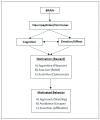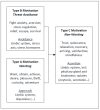The ABC Model of Happiness-Neurobiological Aspects of Motivation and Positive Mood, and Their Dynamic Changes through Practice, the Course of Life
- PMID: 35741364
- PMCID: PMC9220308
- DOI: 10.3390/biology11060843
The ABC Model of Happiness-Neurobiological Aspects of Motivation and Positive Mood, and Their Dynamic Changes through Practice, the Course of Life
Abstract
Background: Happiness is a feeling, an immediate experience, not a cognitive construct. It is based on activity in the brain's neurobiological reward and motivation systems, which have been retained in evolution. This conceptual review provides an overview of the basic neurobiological principles behind happiness phenomena and proposes a framework for further classification.
Results: Three neurobiologically distinct types of happiness exist: (A) wanting, (B) avoiding, and (C) non-wanting. Behind these types lies a dynamic gradation, ranging from the more youthful anticipation, pleasure and ecstasy (A), to stress processing, escape and relief (B) as we find them accentuated in the middle-aged, to deep satisfaction, quiescence and inner joy (C), which is particularly attributed to older people. As a result, the development of happiness and satisfaction over the course of life typically takes the form of a U-curve.
Discussion: The outlined triad and dynamic of happiness leads to the paradoxical finding that the elderly seem to be the happiest-a phenomenon that is termed "satisfaction paradox". This assumed change in happiness and contentment over the life span, which includes an increasing "emancipation" from the idea of good health as a mandatory prerequisite for happiness and contentment, can itself be changed-it is trainable.
Conclusions: Programs for mindfulness, contemplation, or stress reduction, including positive psychology and mind-body/behavioral medicine training, seem to be capable of influencing the course happiness over time: Happiness can be shaped through practice.
Keywords: U-curve of happiness; aging; contemplative practice; life satisfaction; mindfulness; motivational salience; reward; subjective well-being.
Conflict of interest statement
The author declares no conflict of interest.
Figures





Similar articles
-
Healthy happiness: The effect of happiness in promoting brain health.Prog Brain Res. 2025;293:127-148. doi: 10.1016/bs.pbr.2025.03.004. Epub 2025 Mar 25. Prog Brain Res. 2025. PMID: 40441779 Review.
-
The neurobiology of pleasure, reward processes, addiction and their health implications.Neuro Endocrinol Lett. 2004 Aug;25(4):235-51. Neuro Endocrinol Lett. 2004. PMID: 15361811 Review.
-
The U-Curve of Happiness Revisited: Correlations and Differences in Life Satisfaction Over the Span of Life-An Empirical Evaluation Based on Data From 1,597 Individuals Aged 12-94 in Germany.Front Psychol. 2022 Apr 28;13:837638. doi: 10.3389/fpsyg.2022.837638. eCollection 2022. Front Psychol. 2022. PMID: 35572301 Free PMC article.
-
The U Shape of Happiness Across the Life Course: Expanding the Discussion.Perspect Psychol Sci. 2020 Jul;15(4):898-912. doi: 10.1177/1745691620902428. Epub 2020 May 6. Perspect Psychol Sci. 2020. PMID: 32375015 Free PMC article.
-
The effectiveness of mindfulness based programs in reducing stress experienced by nurses in adult hospital settings: a systematic review of quantitative evidence protocol.JBI Database System Rev Implement Rep. 2015 Oct;13(10):21-9. doi: 10.11124/jbisrir-2015-2380. JBI Database System Rev Implement Rep. 2015. PMID: 26571279
Cited by
-
Validation and Psychometric Properties of the Italian Version of the Unconditional Self-Kindness Scale (USKS).Int J Environ Res Public Health. 2023 May 16;20(10):5839. doi: 10.3390/ijerph20105839. Int J Environ Res Public Health. 2023. PMID: 37239565 Free PMC article.
-
Mindfulness-Based Cognitive Therapy in Clinical Practice: A Systematic Review of Neurocognitive Outcomes and Applications for Mental Health and Well-Being.J Clin Med. 2025 Mar 3;14(5):1703. doi: 10.3390/jcm14051703. J Clin Med. 2025. PMID: 40095733 Free PMC article. Review.
-
Validation of the Italian version of the Neuroception of Psychological Safety Scale (NPSS).Heliyon. 2024 Mar 16;10(6):e27625. doi: 10.1016/j.heliyon.2024.e27625. eCollection 2024 Mar 30. Heliyon. 2024. PMID: 38533067 Free PMC article.
-
Perceived health, quality of life and happiness among older professional artisans in a UNESCO Creative City of crafts and folk art.Front Psychol. 2025 May 9;16:1536447. doi: 10.3389/fpsyg.2025.1536447. eCollection 2025. Front Psychol. 2025. PMID: 40417025 Free PMC article.
-
The BERN Framework of Mind-Body Medicine: Integrating Self-Care, Health Promotion, Resilience, and Applied Neuroscience.Front Integr Neurosci. 2022 Jul 14;16:913573. doi: 10.3389/fnint.2022.913573. eCollection 2022. Front Integr Neurosci. 2022. PMID: 35910341 Free PMC article. Review.
References
-
- Esch T., Stefano G.B. The neurobiology of pleasure, reward processes, addiction and their health implications. Neuroendocrinol. Lett. 2004;25:235–251. - PubMed
Publication types
LinkOut - more resources
Full Text Sources
Research Materials

